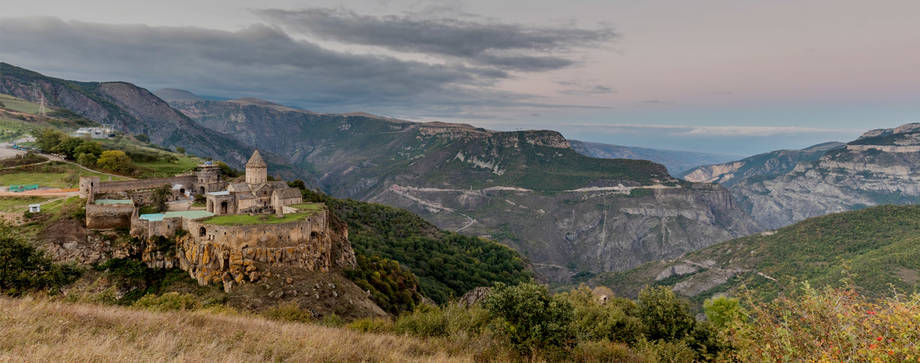Armenia is a landlocked country with limited natural resources, covering an area of 29 800 km2 and an estimated population of 2.97 million (2018). It is located in the Caucasus region, neighboring Georgia, Azerbaijan, Iran and Turkey. It is essentially made up of high rolling plateau and wide river valleys, together with sharp mountain ridges from the southern edge of the Caucasus range. The average elevation is about 1 650 m. The climate is continental with hot summers and cold winters and annual rainfall varying between 300 mm in the low-lying Ararat plains to about 600 mm in the rest of the country.
The greatest part of Armenia is mountainous (about 1 800 meters above sea level), while one-third is pastureland. A land of rugged mountains and extinct volcanoes, its highest peak is Mount Aragats, 4 095 m. There are more than 200 streams and rivers in Armenia, none navigable, however, because of their steep descents and rapid currents. The Armenian countryside also boasts some 100 small, but picturesque lakes. One of the largest mountain lakes in the world, Lake Sevan, covers an area of 1 400 square kilometers and is about 2 000 meters above sea level.
The capital city, Yerevan, lies on the Hrazdan river, and is home to some 1.2 million people.
The diversity landscapes and ecosystems in Armenia along with relief peculiarities, vertical zonation and ten landscape-climatic zones contribute to formation of rich and unique plants diversity. Armenia is a globally significant center of origin of agrobiodiversity. The great specific and intraspecific composition of plant in Armenia is conditioned also by country’s location in the intersection of important provinces of formation of flora and fauna of the region. Consequently, on the small territory of the country there are about 3 800 species of vascular plants with notable level of endemism (3.8% of total flora). By the density of high vascular plants Armenia is ranked among first-place countries in the world with about 107 species per 1000 km2.
Plant genetic resources for food and agriculture are represented in the Republic by different crop species of economic value, crop wild relatives, traditional farmer’s varieties and wild food plants.
Armenia has 2.974 million ha of land, of which 2.043 million ha is considered agricultural land (0.69%). The total area of arable land is 446.0 thousand ha (21.8% of agricultural lands), out of which 68.1 thousand ha is concentrated in Ararat valley (15.2 %). More than 57% of agricultural land in Armenia is pastures and meadows. Around 29.1% of cultivable land is not utilized for various reasons. According to census results from 2014, in average 33 % of arable land in holdings without legal status and 38 % of holdings with the legal status are abandoned.
At present, the agricultural sector remains essential for the economy of the country. Agriculture is the main source of economic activity in rural areas and significant contributor to GDP. It produces 14.9 % of GDP (as of 2017) and employs about 36.6 % (2017) of the working population of whom nearly 56% are female farmers. Women are over-represented in seasonal and precarious employment and 82.1% of all women working in agriculture do so informally. This informality, which leads to a reduced access to social protection schemes, along with limited access to land and other agricultural assets compared with men, leave women in a vulnerable situation.
Farm structure in Armenia, like in many other countries in the region are dominated by a large number of small-scale farms with fragmented land holdings. According to 2014 census data, the 317,346 family farms, which contribute more than 97% of total agricultural output, comprise 99.86% of all active agricultural holdings. 45% of the farms have three or more land plots, and 20% of farms have 5 or more plots. Smallholders constitute the vast majority in the country, representing around 95% of all farms and produce the major part of gross agricultural product, around 97%.
According to MoA data, the level of self-sufficiency in the country in terms of most relevant food products is around 64%. This percentage mainly corresponds to potatoes, fruits, grapes, vegetables, lamb, eggs and fish. Wheat, legumes, oil, and other types of meat are still on a low level of self-sufficiency. Armenia relies heavily on grain imports, especially cereals.
The livestock sector is dominated by cattle and small ruminants and it is based on traditional husbandry systems; few animals per herd and close association of different animal species, which makes extremely difficult the control of animal diseases.
The targeted development of agriculture will contribute to an increase in food sufficiency and an improvement in living standards for the entire nation. Viticulture and fruit growing are the priority sub-sectors of Armenian agriculture. Armenians have always favored viticulture. The fame of Armenian "sun-flavored" cognacs (brandy) and wines is largely attributable to the special quality of Armenian grape varieties. Furthermore, the agro-ecological conditions, the geographical position of Armenia and the multipurpose use of vegetables have led to a great diversity of vegetable varieties.

